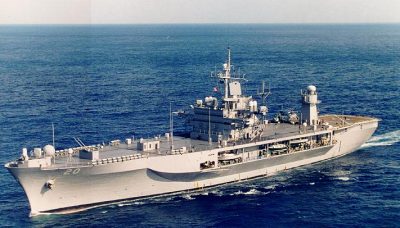US Continues to Challenge Russia’s Sovereignty in the Black Sea

All Global Research articles can be read in 51 languages by activating the “Translate Website” drop down menu on the top banner of our home page (Desktop version).
To receive Global Research’s Daily Newsletter (selected articles), click here.
Visit and follow us on Instagram at @crg_globalresearch.
***
Last Thursday, the flagship of the US 6th Fleet, USS Mount Whitney, entered the Black Sea as NATO forces prepared for large-scale military exercises in the Mediterranean. USS Mount Whitney joined the guided missile destroyer USS Porter that was already present in the area to conduct a “routine patrol” – over 8,000km away from the North American continent.
Later, the Russian frigate Admiral Essen conducted exercises simulating a response to an enemy air attack. The Russian fleet said in a statement that “during the exercises, the [Admiral Essen] frigate’s air defense team fixed the targets in their crosshairs and destroyed them by firing anti-aircraft missiles.” The exercise was a clear demonstration that Russia is fully prepared to defend its sovereignty in the Black Sea. This was perfectly encapsulated by an image of what appears to be the Admiral Essen frigate monitoring the actions of USS Porter, USS Mount Whitney and Bulgaria’s BGS Gordi in the Black Sea.
The Russian warship is one of the three frigates from Project 11356 that is operating in the Black Sea. The ships in this series have a displacement of about 4,000 tons, a speed of 30 knots and an autonomy of 30 days. Admiral Essen is equipped with Kalibr cruise missiles, the Shtil-1 anti-aircraft defense system and 100mm caliber artillery batteries, among other things. In short, by using the Admiral Essen frigate, Russia is sending a powerful message to NATO that it is taking the defense of its maritime space seriously, especially since the June debacle of Britain’s HMS Defender is still fresh in the memory.
Russia has repeatedly warned NATO that the bloc’s growing activity near Russian waters could result in unwanted incidences. By sending warships to the Black Sea, Washington is not contributing to stability in the region. On the contrary, the US is trying to push regional Black Sea countries, such as Bulgaria and Georgia, towards confrontational policies against Moscow.
Washington wants the global community to get used to the idea that the Black Sea is in its sphere of influence. Due to the US’ attempts to assert its authority over the Black Sea, the location of several Russian ice-free ports and the country’s only direct access to the Mediterranean Sea, tensions are developing.
Russia already demonstrated its resolve in defending its sovereign territory when HMS Defender was humiliated after attempting to violate Russian maritime space. Knowing that Russia takes its security seriously, Washington is provoking tensions between two nuclear powers. There is an impression that the US is providing psychological support to Ukraine and other peripheral NATO partners like Georgia. However, as was demonstrated during the 2008 South Ossetia War and the 2014 Donbass War, the US is willing to embolden and encourage these countries into wars that will involve Russia, but leave them abandoned and isolated when faced against the Russian military.
It is worth noting though that the Russian exercise is not a direct response to the presence of American warships, but rather because Russian forces in the Black Sea area need constant training as the region is becoming more tense. The latest Russian exercise occurred just as American warships entered the Black Sea. It is common for an American ship to appear in the Black Sea on a rotating basis. What makes the current situation with the USS Mount Whitney and USS Porter different is that this time two ships entered at the same time. This is alarming, especially if it will become a regular trend to see multiple American warships in the Black Sea.
Due to this escalation, Russia needed to respond in one way or another, and its latest exercise in the Black Sea aligned with the rare entrance of multiple US warships in the Black Sea. By responding in such a way, even if it was an accidental alignment, the US and its NATO allies will always need to consider what the Russian response will be if the Atlantic bloc decides to engage in hostilities.
Despite Britain’s humiliation in June, US-led NATO forces have evidently not given up their challenges against Russia at sea. It is recalled that in October, the US Navy destroyer USS Chafee tried to violate Russia’s national border in the Sea of Japan, but was forced to withdraw under pressure from Russia’s large anti-submarine ship Admiral Tributs. Although the US is undoubtedly pulling its resources to focus on opposing China in the Pacific region, it does not mean that the US has completely withdrawn from challenging Russia elsewhere. In fact, by sending USS Mount Whitney and USS Porter to the Black Sea simultaneously, the US has only escalated tensions and made its intentions clear.
*
Note to readers: Please click the share buttons above or below. Follow us on Instagram, @crg_globalresearch. Forward this article to your email lists. Crosspost on your blog site, internet forums. etc.
Featured image is from cv.wikipedia.org

